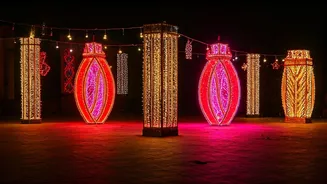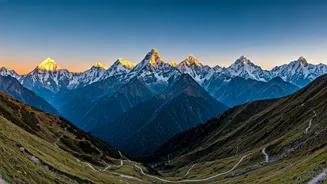Explore Ancient Wonders
India's heritage landscape is brimming with iconic sites, each telling a unique story. For travelers eager to delve into the heart of India's history and culture,
visiting these landmarks is an absolute must. The first stop could be the Ajanta Caves. Carved into the Sahyadri hills, these ancient Buddhist cave monuments showcase stunning murals and sculptures that depict the life of the Buddha. Next on the list could be the Ellora Caves, showcasing a mix of Buddhist, Hindu, and Jain cave temples. Further, the forts and palaces of Rajasthan stand as symbols of royal grandeur and architectural brilliance, offering a glimpse into India's rich past. The Taj Mahal is the most renowned monument. Built by Mughal emperor Shah Jahan for his beloved wife Mumtaz Mahal, the Taj Mahal is a testament to love and architectural genius.
Unveiling Architectural Marvels
Indian heritage sites showcase diverse architectural styles, reflecting the country's rich history and cultural influences. From the intricate carvings of temples to the majestic forts of the Mughal era, each site presents a unique architectural narrative. For example, the ancient temples of Khajuraho exhibit exquisite sculptures, displaying the skill of Indian artisans. The architecture varies widely across India, reflecting the different dynasties that ruled the region. In the south, Dravidian temples are distinguished by their towering gopurams, while in the north, the Nagara style features curvilinear towers. These architectural marvels tell stories of faith, power, and artistic ingenuity, enriching the experience of any visitor.
Journey Through Time
Visiting India's heritage attractions is akin to stepping back in time, offering a deep dive into the country's history and the lives of those who came before us. The forts and palaces of Rajasthan, for example, transport visitors to an era of royal splendor and strategic prowess. Within the walls of these ancient structures, travelers can discover the tales of kings, queens, and battles. Each visit to a heritage site unveils the layers of history, providing a comprehensive understanding of India's past. Exploring these locations, visitors can develop an appreciation for India's cultural diversity and historical depth. From the ancient ruins of Nalanda to the colonial architecture of Mumbai, each site tells a unique story.
Cultural Immersion Awaits
Beyond the historical significance, visiting Indian heritage sites is also a chance to immerse oneself in the local culture. Traditional art forms, music, and dance come alive, showcasing the cultural richness of the region. Many of these sites host cultural events and festivals, making them centers of cultural activity. For example, the Meenakshi Amman Temple in Madurai is a vibrant hub where visitors can witness elaborate rituals and cultural performances. Exploring the local culture through these heritage locations gives visitors a deeper appreciation for the local traditions. The experience of the culture provides insight into the lives, beliefs, and traditions of the people who have lived in these regions for centuries. This immersion enhances the experience of travel and deepens the connection to the heritage sites.
Planning Your Visit
Planning a trip to India's heritage sites needs careful consideration. Travelers should be aware of factors like optimal times to visit, entry fees, and local customs to ensure a smooth journey. Before starting, one should check local weather conditions and plan accordingly. Consider arranging transportation to visit the site, be it by train, bus, or hired vehicles. Booking tickets and accommodations beforehand can help one avoid any inconvenience. Visitors should also dress modestly and be mindful of local traditions. By taking the time to do some research and plan effectively, travelers can create a memorable and enriching travel experience. A well-planned visit ensures that every traveler makes the most of their time and creates lasting memories while exploring these remarkable historical sites.











